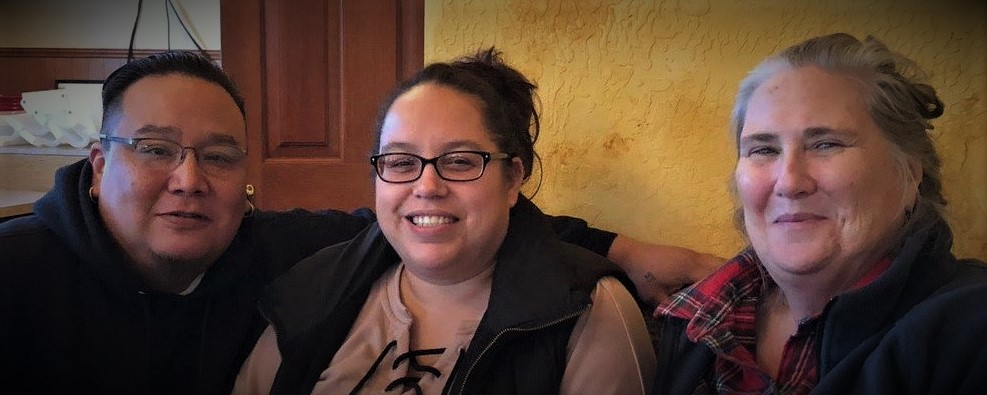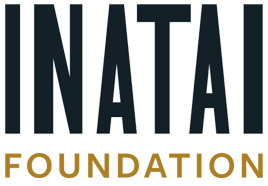Resources | Reports
A Year on The Road
Downloads
Introduction:
Report PDF:

Photo: In memory of David Jackson Jr., pictured from left to right: David, Beverly Lee, and Ann Simpson in Forks, where David invited our team to listen and learn from his community.
In fall 2018, we began an intentional effort to focus our earliest relationship-building with communities most impacted by health inequities and communities that have been historically left out of philanthropic funding—particularly rural communities and mid-sized cities across the state.
A Year on the Road: Guidance from Community Leaders and Organizations Across Washington
shares the insights and advice we received from organizations and leaders at the forefront of powerful work to address the root causes of inequities—organizations led by people of color, Indigenous people, immigrant and refugee people, people with disabilities, LGBTQ people, and people experiencing poverty in Washington’s 39 counties, tribal nations, and urban Native communities.
The report highlights the valuable guidance we received about how to be an effective and respectful grantmaking partner. It describes how leaders and organizations define health as something far more expansive than a medical model of well-being. It also shares how groups are organizing to build community power to guide decision-making about all that impacts Washington’s communities: safe and affordable housing, strong schools, connections to culture, reflective and accountable government, and more.
Community guidance
We are incredibly grateful for the candor and guidance we received. Here are some of the themes we gathered:
- Leaders said how meaningful it is to be able to build local connections with a funder. We were advised to build relationships and deepen our understanding of Washington State by locating offices outside of the Seattle metro area. We were encouraged to enter communities with humility. We are taking this advice and have made the decision to open offices throughout Washington.
- We were advised to have staff and board with lived experiences of inequity, and staff and board who have spent their professional life working in a broad range of communities across Washington. We are working to ensure our hiring processes reflect this emphasis as an element of qualification.
- Leaders expressed the value of long-term relationship building. Funders need to commit the time it takes to build trust with communities. They advised us to have a process to acknowledge when mistakes are made and to reconcile.
- Leaders shared the importance of defining the words we use. A community member in Yakima advised, “You and I might mean different things when we say community engagement. Tell us how you define words, and be open to hearing that we might define things differently.” One way we are trying to heed this advice is by developing a glossary of terms and principles. We are also seeking to be responsive and hold ourselves accountable to what we are hearing from communities. We are committed to documenting, sharing, and hearing feedback about our approaches to this work.
- We heard how organizations are frustrated that foundations are increasingly using the term “equity” without making significant changes in practices or funding decisions. Leaders shared that they have seen funders attend equity convenings, write blogs, and give speeches about equity, but that they are not seeing dollars go to people of color-led, immigrant and refugee-led, disability-led, LGBTQ-led, and poor people-led groups or organizations located in rural and mid-sized cities that have been historically underfunded.
- We heard from some white rural leaders who believe that money is not flowing to their rural communities because funders have shifted their focus to “equity.” They believe that the lack of resources they are seeing is due to new attention being paid to communities of color. While we heard this sentiment many times, there is no evidence that the percent of dollars going to organizations led by people of color is increasing. This surfaced an ongoing challenge that people of color are still not being seen in their communities, and their efforts are not being funded.
- We were repeatedly advised that funders should track and report publicly who is receiving funding to advance equity, whether these groups are led by communities most impacted by inequity, and where these organizations are located and working. We are looking to address this in our work. In our recent open grantmaking process, we included questions for applicants about their board and staff demographics and how they are reflective of the communities they serve.
- Organizations shared the importance of funding groups that center equity in their work and whose leadership is reflective of and accountable to the communities they serve. When funders support organizations who are not centering equity and are given a pass, philanthropy is then a part of perpetuating inequities in Washington.
- We heard how white-led organizations have benefitted from philanthropic practices to the detriment of people of color-led organizations. An example that was repeatedly cited was how funders have historically supported capital campaigns of white-led organizations. This funding has enabled white-led organizations to buy their buildings and develop assets, while people of color-led, LGBTQ-led, and poor people-led organizations have largely been ignored for capital investments. Other organizations that have been started more recently shared that philanthropy has moved away from capital investments. This has left out entire communities from building wealth and assets. This inequity is compounded by the fact that organizations led by people of color and tribal nations often receive a larger share of funds from government grants, which don’t typically provide funding for capital purchases.
- Leaders shared the importance of funding organizations with smaller budgets, as well as culturally-specific groups who are led by and have deep relationships with communities most impacted by inequities. They also talked about the need to fund groups in rural communities and smaller cities that are led by people of color, immigrants and refugees, persons with disabilities, and people experiencing poverty—groups that have been often ignored by philanthropy in the past.
- Even though there is a lot of wealth in Seattle, culturally-specific groups and groups led by people of color continue to be kept out of accessing these dollars. Leaders shared that the wealth of Seattle-based philanthropic donors isn’t reaching the organizations led by communities most impacted by inequities. In addition, these organizations shared that they have a difficult time attracting regional and national funding since it is assumed proximity to Seattle’s philanthropic sector means organizations are benefiting from these donors.
- Leaders advised us to understand the roles of intermediaries and when partnering with them makes sense and when partnering could lead to greater barriers for nonprofits. We were advised to build relationships with and fund organizations directly, as well as take the time to invite local organizations to share more about their experiences with intermediaries.
- Leaders expressed how important transparency in decision-making is to them. They advised us to practice transparency and to be clear why a group was funded or not funded.
- We heard how helpful simple and accessible application processes are. Organizations shared their appreciation for when funders accept applications in various formats, translate materials into various languages, and ensure that applications can be filled out in a person’s home language. We have also heard about the need to submit applications by mail or fax when there is limited internet access. We have worked to follow this guidance in our first grantmaking effort and continue to learn how to ensure our processes are accessible.
- We were advised to be very cautious about evidence-based evaluation. Evidence-based evaluation has typically set white communities as a baseline without analysis of how racial inequities in systems have led to current realities. Evidence-based evaluation also leads to the assumption that a program that was effective in one community will work in another, when in fact it may cause harm. As the result of this guidance, we are developing a set of commitments to reflect back what we heard and hold ourselves accountable for how we will engage in things like research, data, and evaluation.
- Organizations in every corner of the state advised us to prioritize general operating support (“unrestricted” funding). General operating support allows organizations to spend money where it is most needed and demonstrates trust in the leadership of the organization. There was a sensitivity about the need for general operating funds since leaders felt they have been giving this advice to funders for a long time.
- We were advised to fund at the pace of relationship-building and opt for long-term funding cycles.Leaders shared that three years is the minimum amount of time philanthropy should fund a single organization. Five to 10 years is needed to build generational and long-term transformational change.
